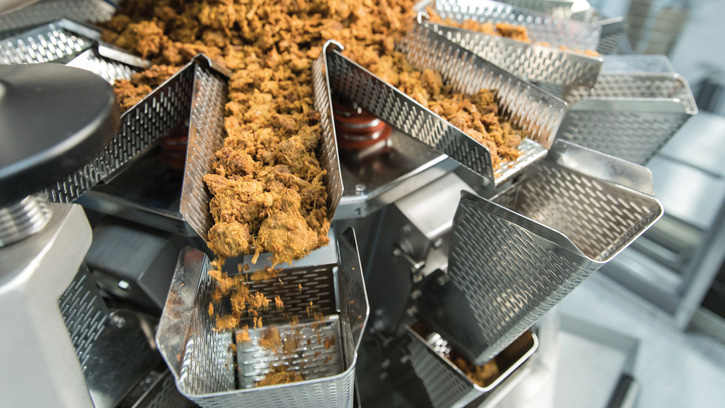You’ve Heard of ‘Alt Meat.” How About ‘Oat Meat’?
STARTUPS & INNOVATORS
By now, “alt meat” is hardly a new idea. From traditional products such as MorningStar Farms veggie burgers, to newfangled competitors like Impossible Burger that add elements such as heme and potato protein, to cutting-edge wannabes that are teasing mycoproteins and hydrogenotrophs into blobs of tissue, the category already is filled with technological and commercial possibilities that arguably could satisfy every conceivable consumer desire.
But Maija Itkonen doesn’t see the alt meat market that way. She believes there’s still plenty of room there for Pulled Oats, a business-to-business and consumer product made by her Helsinki-based company, Gold&Green. Itkonen says Pulled Oats will steadily gain traction in this very crowded derby thanks to its unique and clean ingredients, proprietary manufacturing process, and sustainability narrative that’s as pristine as the Scandinavian fields where the main raw material is grown.
Pulled Oats, which is the first oat-based alt meat to be commercialized, Itkonen says, contains 33 grams of protein per four-ounce serving, is free of cholesterol, and is low in saturated fat. It’s got a simple ingredient list, unlike some other alt meats, and contains no animal-based or GMO ingredients; no fillers, preservatives, or additives; and no soy.
A lifelong vegetarian, Itkonen is an industrial designer by training. The idea of combining her vocational and avocational interests occurred to her on an airplane in 2014, when she stumbled across an article about fake meat. That led her to ponder the possibilities for one of her favorite ingredients, Nordic oats.
Nordic oats thrive in the area’s harsh climate. “The Nordic climate has these long summer nights, with lots of rain, a situation that’s not good for a lot of crops, such as corn, which requires dark nights,” says Itkonen. “But Nordic oats are very different. They can survive when the sun doesn’t go down and there are cold temperatures. It causes them to be very nutrient-packed. And the quality is very much better than elsewhere.”
Nordic-grown oats also are recognized as one of the most environmentally friendly crops on the planet. A regenerative crop, they can significantly reduce nitrogen-fertilizer runoff, soil erosion, and herbicide use while increasing yields and farm profitability. Itkonen says Scandinavian oat farmers tend to go light on chemicals anyway, adding to their case for sustainability.
Itkonen teamed with an oat scientist and a legume scientist to develop an innovative mechanical process that blends Nordic oats with fava beans and yellow peas. “We didn’t want it to be mushy, like some other alt meats,” she says. “Texture and structure were going to be important.”
So Itkonen traversed as far as China, where she studied manufacturers’ approach to making tofu from soy. One thing the Gold&Green team had to overcome: Oats can be slimy to handle because of their beta-glucans, and they don’t behave the same way as legume proteins. Itkonen describes the process her team developed as almost like bread-making, with mixing, pressing, and heating.
“The main thing in our manufacturing process is it doesn’t involve any chemicals,” she says. “Nothing needs to be added. It’s like the ingredients are almost involved in a baking process. They are heated, and there is mechanical blending.”
Market Penetration Grows
Pulled Oats are sold in chilled sections of supermarkets in Finland, merchandised in cardboard boxes with an interior package, as an analogue to pulled or shredded meats that consumers make the centerpiece of sandwiches, tacos, and so on. The brand also is penetrating restaurant menus in 16 countries, including the United States and in Europe, as an ingredient that comes in pulled, minced, and crumbled forms. Chefs are working Pulled Oats into nachos, lasagna, Korean poke bowls, and other dishes. It can also be formed into patties like a burger.
“Foodservice has been a really good route to market for us,” Itkonen says. “There is consumer education involved. We have to be able to explain how you can make good food out of this, and having restaurants serve it is a win-win. Chefs say it works a lot like tofu, having a neutral flavor that takes on other flavors as well.”
In the end, Itkonen agrees, Pulled Oats must taste good and deliver the right consumption experience overall, regardless of how strong its sustainability narrative may be.




